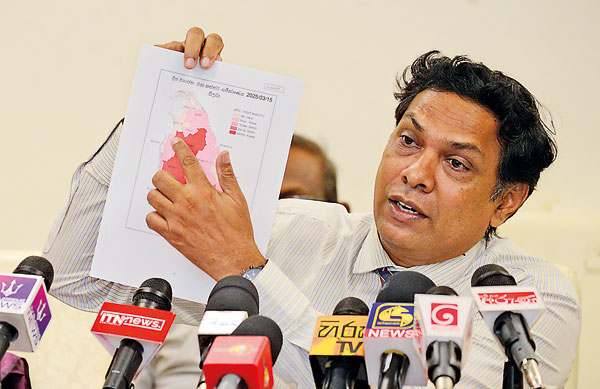News
Experts dismiss animal survey, question accuracy of figures
View(s):By Kasun Warakapitiya
Researchers, environmentalists and agriculture experts refuse to accept the national animal census, which they say is flawed and has many grey areas that need to be rectified.
The reactions came after the Agriculture Ministry on Thursday released the results of the census, with ministry officials claiming that, according to the census, there are 5.17 million toque macaques (Rilawas), 1.4 million grey langurs (Alu Wandura), 2.66 million giant squirrels and 4.74 million peacocks in Sri Lanka.

Statistics only, no report
Although the statistics were read out at a media conference, copies of the report were not shared. When asked, the ministry officials said the report had been handed over to Agriculture Minister Lal Kantha and Ministry Secretary D.P. Wickremesinghe for approval, and once they approved it, copies would be shared with the media.
Experts said the problem with the animal census was that it was far from a census, as a proper census involved the collection of data of or from every member of the population. What the Agriculture Ministry carried out was a flawed survey that was equally less expensive and less accurate.
The experts said that although spot census is a scientific method of accessing a count, the methodology used for this specific survey was flawed on many counts.
They said one of the problems was the involvement of the affected people for the count. This gave rise to bias. They are likely to inflate the numbers to support their cause.
Besides, most of the people who counted the animals did not understand the basics of the so-called five-minute census. They had preset notions of filling in the numbers at the time of the census; whether they saw the animals or not was immaterial.
Not knowing the difference between Wandura and Rilawa was another issue which also affected the survey. Moreover, there were complaints that some households were not given the census slip by the Grama Niladari. This was while some people took part in the exercise as a hilarious activity. They either entered some bogus figures or exaggerated the numbers.
Peradeniya University’s senior crop science professor, Buddhi Marambe, said the 5.14 million count of toque macaque monkeys itself showed that the results had been exaggerated.
He said that given Sri Lanka’s human population, the survey showed that there is a “Rilawa” for every four humans.
The senior professor elaborated that farmers and those who were affected by the monkey issues would naturally exaggerate the numbers, assuming it would force the authorities to find a solution.
“The authorities who conducted the survey themselves have admitted that there were shortcomings in the ‘census’. They carried out recounts in selected areas, admitting there were errors,” he added.
Prof. Marambe said he believed that the survey result should not be used for decision-making, but it should be studied to learn where the errors occurred.
He added that if such surveys were done, statisticians should be incorporated into data collection, analysis and interpretation to ensure the accuracy and reliability of the exercise.
The senior professor called on the authorities to carry out another survey—with the help of biologists and statisticians—in areas where there is a higher density of animals.
However, he proposed that based on proper survey results, one third of the population of the macaques should be culled using scientific methods in specific areas to control their numbers.
Taya F. Diaz, a former researcher and resident of the Polonnaruwa New Town area, said the manner in which the census was carried out was laughable. Pointing out the methodology used was flawed, he questioned how an unbiased count could be expected from the parties who had a vested interest in the outcome of the census.
Mr Diaz had been involved in research on toque macaques and lived amongst the monkeys in an urban setting for the past four decades. He said many people he talked to were unable to identify macaques from grey langurs. In his own village, what some call ‘rilawa’, others call ‘wandura’.
Another deficiency in the ‘census slip’ given to residents is the omission of Kalu wandura—purple-faced langur.
Mr Diaz criticised the authorities for not making public the entire report.
The Sunday Times learned most people were unable to differentiate macaque monkeys from grey langurs or purple-faced langurs, which are listed as endangered. Of the five subspecies of purple-faced langur, the western subspecies Semnopithecus vetulus nestor, found mainly in home gardens and rubber plantations in the western lowlands, is listed as ‘critically endangered’ by IUCN.
Another researcher, Supun Lahiru Prakash, said the method adopted for the animal census was used internationally, but what happened in Sri Lanka was that most participants had a vested interest, and therefore their input lacked credibility.
Drawing attention to the politicians’ stance before the survey that there were an excessive number of animals in the country, he said such views affected the public perception.
Mr Prakash said that although the results might not be entirely accurate, they underscored the seriousness of the issue and highlighted the urgent need for effective mitigation strategies and a national-level response.
Environmental lawyer Jagath Gunawardena pointed out that making decisions based on a flawed survey could be counterproductive.
“If a proper survey is carried out, it should account for distribution, differences of subspecies, and the specific number of animals in a given area,” he said.
The census was carried out without considering subspecies and did not look into which subspecies of animals were in excess or causing damage.
“There are three subspecies of giant squirrels and four subspecies of toque macaques; therefore, the census should give a breakdown of the animals and the extents of their distribution; then only a proper understanding could be made,” he said.
Agriculture Ministry Secretary D.P. Wickremesinghe said the report had been given to him to study the results and take necessary action.
The best way to say that you found the home of your dreams is by finding it on Hitad.lk. We have listings for apartments for sale or rent in Sri Lanka, no matter what locale you're looking for! Whether you live in Colombo, Galle, Kandy, Matara, Jaffna and more - we've got them all!

